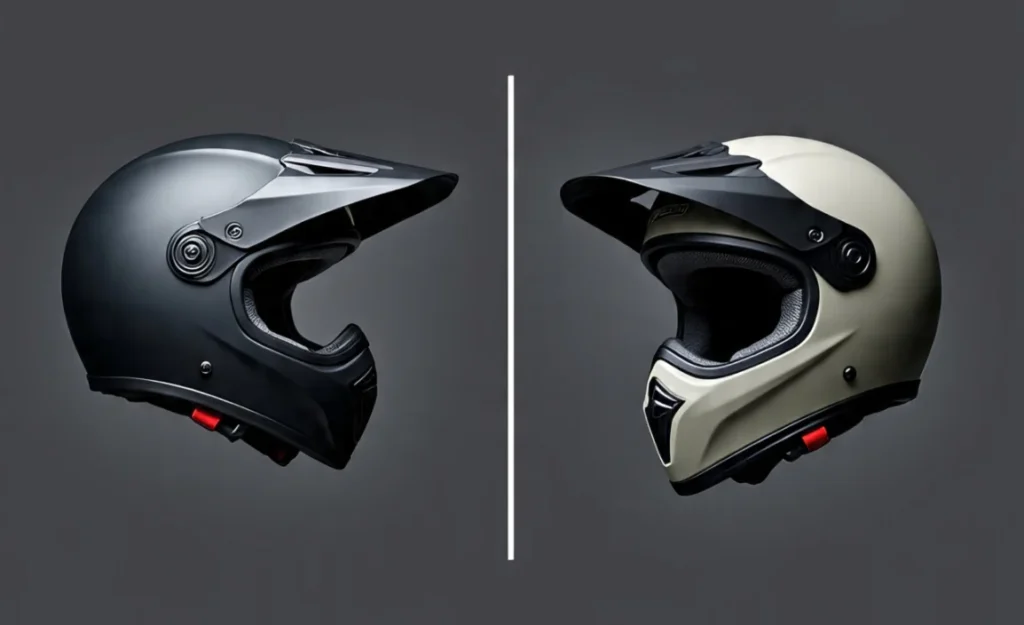To sum it all up: A modular helmet offers comfort, convenience, and safety, all in one. It’s not just a helmet. It’s a solution to the real problems bikers face every day.
If you’ve ever searched for motorcycle helmets, you know how confusing it can be. So many options, styles, safety ratings, features, it’s overwhelming. I’ve been riding for years now, and let me be honest, finding the perfect helmet hasn’t always been easy. So, what is a modular helmet?
Tired of carrying your helmet everywhere? Learn the smartest ways to securely lock your motorcycle helmet to your bike and ride worry-free.
But a while ago, I came across something that changed my whole experience: the modular helmet. If you’re a biker like me who commutes daily, rides long distances, or even just hops on the bike for short weekend getaways, then keep reading because I’m going to explain everything you need to know about modular helmets and why they might be a perfect fit for you.
Let’s dive in.
So, What Is a Modular Helmet Anyway?
A modular helmet, also called a flip-up helmet, is a hybrid between a full-face helmet and an open-face helmet. It has a special hinge mechanism that allows the front portion (the chin bar and visor) to flip up, turning it into an open-face helmet temporarily.

That means you get the protection of a full-face helmet when you’re riding, but when you stop at a red light or a fuel station, you can flip it open to catch a breath, talk to someone, or even sip water, without taking your helmet off.
I bought my first modular helmet when I started commuting longer distances. I got tired of removing my full-face helmet every time I needed to speak to someone or check directions on my phone. A friend recommended a modular one, and trust me, it was a game changer.
Upgrade your ride with sound! Discover how to add crystal-clear audio to your CHIPS wireless helmet in just a few steps.
Why Bikers Like Us Are Switching to Modular Helmets
Let me break down why modular helmets are growing in popularity, especially among touring riders, daily commuters, and those who ride in warmer climates like Australia.
1. Convenience That Actually Matters
Picture this: you’re riding to work, stop at a red light, and your glasses fog up. With a full-face helmet, you either deal with the fog or take the whole helmet off. With a modular helmet, you just flip the front up, clear the fog or wipe your glasses, and flip it back down. That simple flip saves you time and effort.
I often find myself flipping mine open at toll booths or petrol stations. No awkward helmet removal. Just flip, talk, flip back. Done.
2. Better Ventilation
We all know how hot Aussie summers can get. I’m talking sweat-dripping-under-the-visor kind of heat. One big reason I switched was that modular helmets offer more ventilation. You can open the chin bar when stopped, and many models have good airflow even when closed.
If you ride in the city or sit in traffic often, you’ll thank yourself for getting a helmet that lets you breathe.
3. Built-in Sun Visors and Communication Features
Most modular helmets come with a retractable sun visor, which means no more swapping visors or carrying sunglasses under your helmet. It’s just a quick slide and boom, shade on demand.
Some helmets also come pre-installed with Bluetooth compatibility or have space for intercom systems. If you ride in groups or use GPS directions, this is gold.
Modular vs Full-Face: What’s the Real Difference?
This is a question I asked myself when I was helmet shopping. Both styles offer protection, but the key difference lies in flexibility.

- Full-face helmets are a single solid shell. Once it’s on, it’s on. No flipping, no opening the front.
- Modular helmets let you flip open the front, making them more versatile.
In terms of safety, full-face helmets are slightly ahead because the chin bar is permanently fixed and usually more reinforced. However, modular helmets still meet high safety standards in Australia and are legal for road use, so it’s not like you’re compromising heavily on protection.
If safety is your biggest concern and you often ride at high speeds or on tracks, then full-face might be for you. But if you do daily rides, city commuting, or even light touring, the benefits of a modular helmet outweigh the few downsides.
Modular vs Full-Face Helmet: Quick Comparison
| Feature | Modular Helmet | Full-Face Helmet |
|---|---|---|
| Design | Flip-up chin bar | Fixed chin bar |
| Comfort | More breathable, easy to open | Snug fit, less airflow |
| Weight | Slightly heavier | Lighter |
| Noise | Louder | Quieter |
| Safety | Dual-certified (if P/J rated) | Generally stronger protection |
| Convenience | Easy to talk/eat without removal | Must remove for access |
| Best For | City, touring, daily use | Racing, highways |
| Price | Usually more expensive | Often cheaper |
Are Modular Helmets Safe?
Here’s where a lot of riders, including me, get nervous. I mean, a helmet that flips open sounds like it might come apart in an accident, right?
That’s a fair concern, but the truth is, modular helmets are safe, as long as you buy one that’s certified and from a trusted brand.
In Australia, helmets need to meet AS/NZS 1698 or ECE 22.05/22.06 standards. If you’re importing one from Europe, look for the P/J designation, which means it’s been tested and approved for both open-face and full-face use.
So, yes, modular helmets might offer slightly less chin protection than full-face helmets, but if you buy the right one, you’re still getting excellent protection.
Think all helmets are created equal? Think again. Here’s why motorcycle helmets are specifically built for road protection — and how they compare to car helmets.
The Story Behind Modular Helmets
Modular helmets weren’t always around. In the early days, riders only had open-face helmets. These didn’t protect your jaw or face at all. In the 1960s, full-face helmets were introduced, which changed the game in terms of safety.
But they weren’t perfect either. Riders missed the airflow and ease of communication that open-face helmets offered. So helmet manufacturers started working on a hybrid, and that’s how modular helmets were born.
Now, they’re the go-to helmet for a lot of police units, delivery riders, instructors, and touring bikers around the world. And yes, people like me who just want something that works well in real life.
The Downsides? Yeah, There Are a Few
To be fair, modular helmets aren’t perfect. Let’s talk about the downsides so you get the full picture.
1. They Are Heavier
Because of the hinge mechanism and moving parts, modular helmets are heavier than full-face helmets. On longer rides, this can cause a bit of neck strain.
Personally, I noticed the difference on my first 300km trip. But for city riding and daily commutes, I hardly feel it anymore.
2. They Can Be Noisier
Modular helmets are not as aerodynamic as full-face helmets. This means you might experience more wind noise, especially on highways.
I use earplugs on long trips and that helps a lot. Some newer models also come with improved insulation and noise reduction features.
3. Higher Price Tag
Modular helmets often cost more than their full-face counterparts. The flip mechanism, added features, and versatility all add to the price.
That said, I consider it an investment in comfort and convenience. And if you look around, you can find some budget-friendly options that still meet safety standards.
Looking to turn heads on every ride? Check out this bold Alien vs Predator motorcycle helmet that blends style with safety.
Modular Helmets Are Especially Great If You…
Let me wrap this up with a little checklist. Modular helmets are perfect for you if:
- You ride in traffic-heavy cities and need to stop frequently.
- You wear glasses and hate struggling to put on or remove your helmet.
- You want to talk to people or grab a drink without removing your helmet.
- You’re into touring and need a mix of comfort and protection.
- You value practicality as much as safety.
And let me tell you from experience, riding in the summer with a modular helmet is like having air conditioning on two wheels. Okay, maybe that’s a stretch, but it’s definitely better than suffocating behind a full visor.
Final Thoughts: Is It Worth It?
So is a modular helmet worth buying? In my opinion, absolutely yes.
If labour pain is equal to pushing through long rides with a hot, uncomfortable, and hard-to-remove helmet, then a modular helmet is the pain relief we didn’t know we needed. It’s a brilliant blend of protection and comfort. Sure, it’s not perfect, but no helmet is.
I personally use mine almost daily. Whether I’m riding to work, heading out for groceries, or exploring new routes on weekends, I love the flexibility and ease it gives me.
Just make sure you buy from an authorised dealer and check for the right safety certifications. That way, you’ll be protected and legal on the road.





